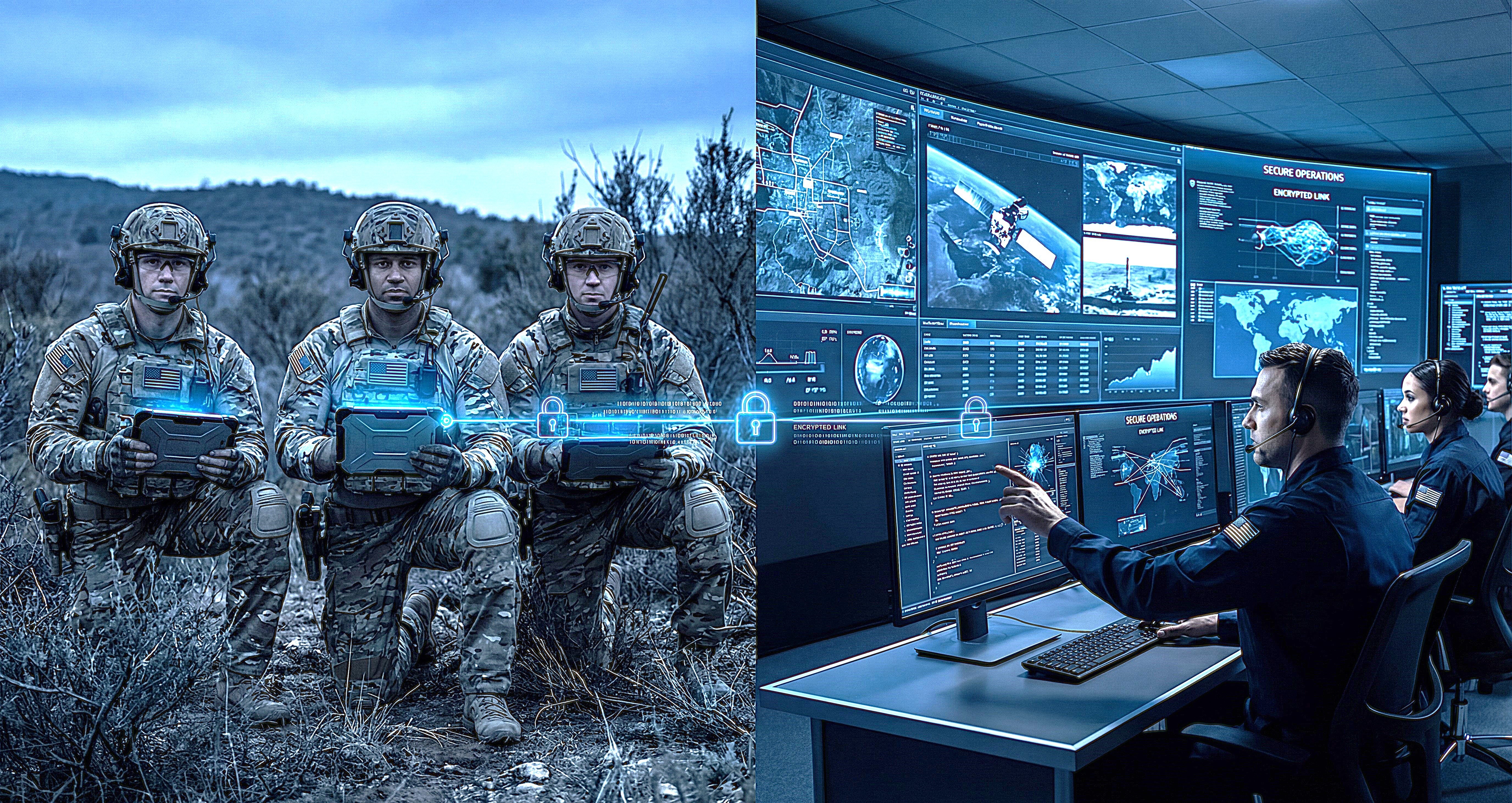Connect with us

How Technology Enables Precise Communication and Coordination in the Defense Industry
In the high-stakes defense sector, where the margin for error is razor-thin, communication is everything. Imagine coordinating over 1.3 million active-duty personnel across the globe. That's the reality for the United States, home to one of the world's largest military forces.
This sheer size underscores the need for seamless communication. It's about ensuring messages are sent, clear, received, and correctly understood, no matter the circumstances.
Seamless communication is the backbone of operational success and safety. It allows troops to move as one, make rapid decisions, and stay several steps ahead of challenges. Without it, the risks are real and potentially devastating.
Why Seamless Communication Is Vital in the Defense Industry
In the defense industry, seamless communication holds everything together, turning individual actions into a coordinated symphony of strategic operations. Without it, the precision and effectiveness of military efforts could unravel, exposing vulnerabilities and compromising mission success.
Enhancing operational efficiency
Effective communication is the foundation of successful coordination and swift decision-making within the defense sector. It bridges the gap between complex military operations and the execution of those plans with precision. Every team member is aligned with the mission's objectives, strategies, and tactics when communication flows unhindered across the ranks.
This alignment facilitates coordination among various units, enabling them to operate as a cohesive force. Moreover, clear and concise communication allows for rapid adjustments in response to evolving situations. This approach ensures teams make decisions quickly and implement them effectively, enhancing military forces' overall operational efficiency and responsiveness.
Active listening skills are crucial in fostering effective communication within the military. Successful military leaders are adept listeners who recognize the importance of understanding their subordinates' perspectives, concerns, and suggestions. By actively listening, these leaders gather vital information that could impact decision-making and build trust and respect within their teams.
This trust encourages open communication, where members can freely exchange ideas and feedback, leading to more informed and comprehensive decision-making processes. Active listening creates an environment where communication thrives, enhancing military units' operational capability and cohesiveness.
Ensuring safety and security
Effective communication is a critical safeguard against accidents and security breaches in the defense industry. Clear and secure communication channels enable the prompt sharing of vital information, ensuring all personnel are aware of current threats and operational conditions. This awareness allows teams to implement preventative measures, rapidly respond to potential dangers, and maintain strict security protocols.
Moreover, organizations can preemptively identify vulnerabilities, mitigate risks, and maintain operational integrity by fostering an environment where information flows freely yet securely. Communication is a coordination tool and fundamental to risk management and security within military operations. It directly contributes to the safety and protection of personnel and sensitive information.
Supporting technological advancements
The evolution of communication technologies transformed defense operations, enabling forces to operate more efficiently and effectively globally. Advances in satellite communications, secure messaging platforms, and real-time data exchange have enhanced the ability to coordinate complex operations across vast distances. These technologies guarantee critical information is transmitted quickly and accurately, facilitating instant decision-making and strategic planning.
Moreover, integrating advanced encryption methods has bolstered the security of these communications, protecting them against interception and cyber threats. These technological advancements are paramount, as they provide a strategic advantage by ensuring military units remain interconnected and informed, regardless of their location.
In communication technologies, AI stands out as a game-changer for military readiness and effectiveness in combat. Experts suggest AI can revolutionize defense operations by automating the processing and analysis of vast amounts of data. It enables quicker and more accurate decisions in critical situations.
AI-powered systems can identify patterns, predict threats, and provide actionable intelligence at unprecedented speeds. These features allow military leaders to anticipate and respond to challenges more precisely. Further, it can enhance communication networks, optimizing the flow of information and ensuring it reaches the right people at the right time.
Challenges to Achieving Seamless Communication
Achieving seamless communication within the defense sector is fraught with challenges, from technological hurdles to human factors. These obstacles can disrupt the flow of critical information and hinder operational efficiency, posing significant risks to mission success and safety.
Security concerns
The imperative for secure communications in the defense industry introduces complex challenges to implementing seamless systems. Protecting sensitive information from interception and cyber threats means communication networks must incorporate advanced encryption and cybersecurity measures. However, these security protocols can sometimes reduce the speed and flexibility of communication, creating a delicate balance between operational security and efficiency.
Additionally, ensuring compatibility across various secure platforms and devices further complicates the integration of new technologies into existing frameworks. As a result, the drive for uncompromised security can inadvertently impede the fluidity and accessibility of information. It underscores the intricate task of designing impenetrable and efficient communication systems for the defense sector.
Technological barriers
One of the most significant technological hurdles in achieving seamless communication within the defense sector is the prevalence of outdated systems. While once cutting-edge, these legacy systems struggle to keep pace with rapid technological advancements. Their limitations can hamper communications' speed, reliability, and security, creating bottlenecks in information flow and reducing operational effectiveness.
Further, outdated systems often require extensive maintenance, diverting resources the military could redirect to modernization efforts. The challenge is technical and financial, as updating these systems involves substantial investment in new technology and training.
Compatibility issues represent another major obstacle, as the defense industry relies on many communication devices and platforms, each with its specifications and protocols. Ensuring these diverse systems can work together seamlessly is a daunting task that requires extensive interoperability testing and standardization.
Recognizing the importance of overcoming these challenges, the U.S. Department of Defense has proposed a significant investment in its future capabilities. It earmarked $145 billion for research and development and an additional $170 billion for procurement in its budget.
This substantial financial commitment underscores the Pentagon's determination to address the technological hurdles head-on. It aims to foster an environment where seamless communication can thrive to enhance the overall readiness and effectiveness of the armed forces.
Human factors
Training, organizational culture, and human error profoundly influence communication effectiveness within the defense industry. Adequate training ensures that personnel are well-versed in using advanced communication technologies and protocols. Yet, gaps in training can lead to misuse or underutilization of these systems. Recruiting veterans with a strong military to civilian resume that highlights the necessary training will help reduce the impact of human factors.
Organizational culture is imperative in promoting open and efficient communication. For instance, cultures that encourage transparency and information sharing enhance communication effectiveness. However, those that do not may inadvertently foster barriers to information flow.
Additionally, human error remains an ever-present challenge, with mistakes in communication potentially leading to misinterpretations and operational mishaps. Addressing these human-centric factors is essential for minimizing errors and maximizing the potential of communication technologies. This approach highlights the need for continuous training and culture nurturing to mitigate the impact of mistakes on defense operations.
Strategies for Enhancing Communication in the Defense Sector
Navigating the complex communication landscape in the defense sector requires strategic foresight and innovative solutions. These initiatives can overcome existing barriers and pave the way for a more interconnected and effective approach.
Investing in advanced technologies
Advanced communication tools like Troop Messenger can significantly streamline communication channels within defense teams. They guarantee real-time updates, and team members can share crucial information securely. This platform has a comprehensive suite of features that cater to the unique needs of security operations, fostering a cohesive communication environment.
For instance, the self-note feature lets personnel quickly jot down reminders, ensuring they never lose critical details in the shuffle. Further, the availability of video and audio calls facilitates immediate and clear communication. These features are crucial when written instructions may not suffice or teams must decide swiftly and collaboratively.
Beyond individual features, Troop Messenger's emphasis on team communication enhances the overall operational effectiveness of defense units. The platform supports creating various groups, enabling tailored communication channels for different units or departments. This organization of communication streams guarantees information is directed to the appropriate teams, reducing clutter and enhancing the relevance of communicated content.
Moreover, its focus on security ensures all communications are encrypted and protected, addressing the paramount concern of information security within defense operations. By integrating these features, defense teams can achieve higher coordination and responsiveness.
Implementing robust security measures
Balancing seamless communication with the stringent need for security is a nuanced endeavor in the defense sector. It requires innovative solutions that uphold both principles. One such solution is implementing a distance matrix API, which can significantly enhance operational security while promoting effective collaboration.
This technology calculates the best routes and distances between multiple points, enabling strategic planning and logistics management with heightened efficiency and precision. Defense teams can optimize movements and resource allocation in real-time by integrating a distance matrix API into communication and operational platforms. This approach ensures sensitive information related to troop movements and supply chain logistics is securely managed and communicated.
Moreover, it streamlines coordination and fortifies security measures by providing a robust framework for decision-making. It controls and encrypts access to critical location-based data, safeguarding against unauthorized access and enhancing the overall efficacy of defense operations.
Conclusion
The importance of seamless communication in ensuring operational success, safety, and security within the defense industry is undeniable. As a member of the defense community, you must promote innovations in advanced communication technologies and strategic initiatives.
This commitment enhances the efficiency of operations and fortifies the safety of personnel and information. Embracing the latest innovations and fostering a culture of continuous improvement in communication practices shapes a more resilient and capable defense infrastructure.








